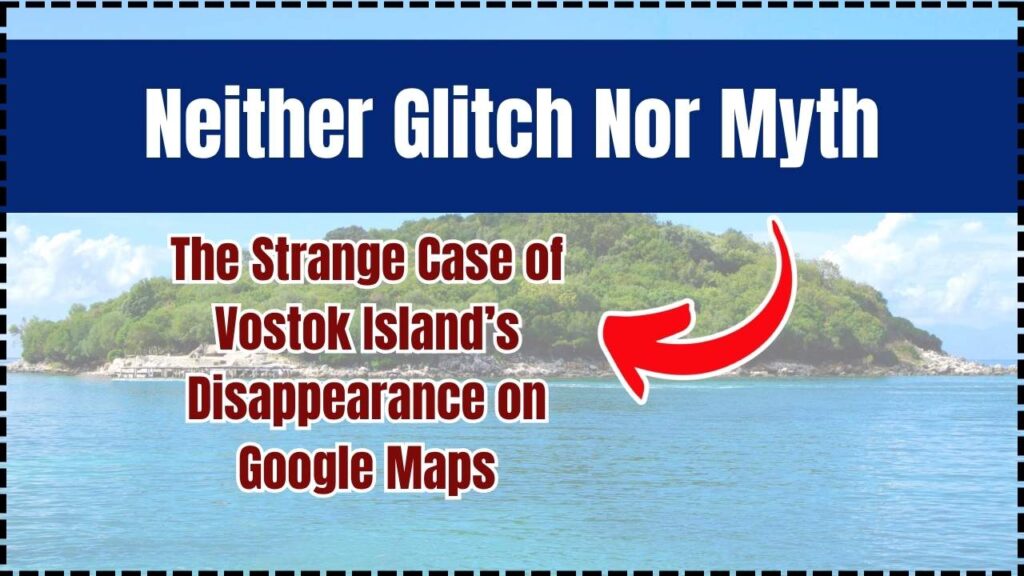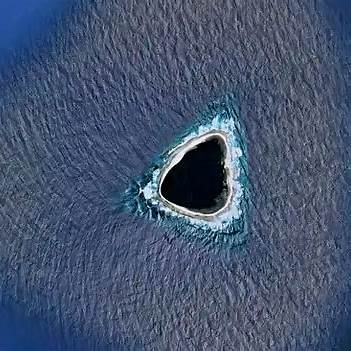
The Strange Case of Vostok Island’s Disappearance on Google Maps: Have you ever stumbled upon something on Google Maps that made you scratch your head? Something that didn’t make sense, or even made you wonder if it was some sort of glitch? If you’ve ever taken a deep dive into the heart of the Pacific Ocean, you might have come across a mysterious phenomenon involving Vostok Island. It’s an uninhabited island that appears like a black hole on satellite images. This unusual visual is enough to make anyone pause and ask, “What is going on here?” Well, let’s uncover the mystery and discover the truth about Vostok Island’s strange disappearance on Google Maps.
The Strange Case of Vostok Island’s Disappearance on Google Maps
Vostok Island’s strange appearance on Google Maps has captured the curiosity of many, and while it might look like a glitch or a secretive spot, the truth is far more natural and fascinating. The dense Pisonia trees that cover the island create an optical illusion from above, making the island look like a mysterious black hole in the ocean. Despite the mystery, Vostok Island is a pristine, ecologically important place, home to rare seabirds and marine life. So, while the island may appear to “disappear” from space, it’s still very much present and thriving in its isolated corner of the Pacific.
Vostok Island is not just a visual oddity but also a reminder of how natural environments, untouched by human hands, continue to captivate and inspire people worldwide. The combination of its mystery and ecological richness makes it one of the most intriguing places on Earth.
| Key Fact | Detail |
|---|---|
| Island Name | Vostok Island |
| Location | Central Pacific Ocean, part of the Line Islands, Kiribati |
| Size | About 1.3 kilometers in length |
| Key Feature | Dense forest of Pisonia trees creates a “black hole” effect from space |
| Notable Phenomenon | Optical illusion of disappearing into the ocean due to dense foliage |
| Ecological Importance | Home to unique marine life and seabird species |
| First Discovery | Vostok Island was first discovered by Europeans in 1820 |
| Local Species | Red-footed booby, great frigatebird, and brown noddy |
What Is Vostok Island?
Vostok Island is one of those places on Earth that leaves people scratching their heads. Located in the central Pacific Ocean, it’s part of Kiribati, a nation made up of a group of islands spread across a vast area. The island itself is quite small, measuring around 1.3 kilometers long, and is shaped like a triangle. But, here’s where things get interesting: the island is completely covered by dense Pisonia trees—trees that can grow up to 30 meters tall and form a thick canopy, blocking out most sunlight from beneath.
Vostok Island is part of the Line Islands archipelago, a region of tiny, isolated islands in the Pacific. Although Kiribati is known for its remote location, Vostok Island stands out due to its geographical and ecological uniqueness. It was first discovered by Europeans in 1820 and, for the most part, remained undisturbed by human hands until relatively recent times. The island is surrounded by the vast, crystal-clear waters of the Pacific Ocean, making it both ecologically significant and a hotspot for scientific research.
When viewed from above, especially via satellite imagery on Google Maps, the island looks like a dark spot or even a “black hole” in the middle of the ocean. This mysterious appearance has led to wild speculations—everything from government cover-ups to the idea that it’s a portal to another world. But, let’s be clear: while Vostok Island’s visual might spark your curiosity, it’s just nature doing its thing. The island is no secret military base, nor is it hiding any alien technology—it’s simply a natural oddity that shows how powerful nature can be when it creates optical illusions.

Why Does Vostok Island Look Like a Black Hole?
At the heart of the mystery is the island’s thick forest of Pisonia trees. The foliage on these trees is so dense that from above, it appears as though the island is completely covered in shadow. The trees block out all other forms of vegetation and give the island its mysterious, dark appearance from space. This dense coverage is due to the fact that Pisonia trees grow in such a way that their leaves and branches overlap extensively, creating an almost impenetrable canopy.
This optical illusion has been the subject of much debate over the years. Some people mistakenly think that the island is a glitch in Google Maps or that the image has been intentionally obscured. In reality, what’s happening is much simpler: the trees, which are tightly packed and reach up to 30 meters high, create a canopy that’s so thick it blocks out light, causing the ground below to appear pitch black from above. The unique forest coverage of Pisonia trees has made Vostok Island one of the most visually striking islands on the planet.
The “Black Hole” Phenomenon Explained
Vostok Island is located in the Line Islands of the Pacific, a place that’s not exactly bustling with human activity. The dense trees, along with the lack of light filtering through the canopy, cause a phenomenon that’s very much natural but looks, from a satellite’s perspective, like a hole in the ocean. The black hole effect is accentuated when the island is viewed from high altitudes, as the dense canopy forms a solid black shape that starkly contrasts with the surrounding clear blue water.
It’s not the first time something like this has happened in nature. There are other places on Earth that have similar characteristics, but Vostok Island’s remote location, combined with its unique appearance from above, has made it a prime candidate for wild theories and discussions. It’s easy for people to get carried away with outlandish ideas when something looks this mysterious.
The Ecology of Vostok Island
Despite its strange appearance, Vostok Island is a biological hotspot with a rich diversity of marine life. The surrounding coral reefs are home to various species, making it an important area for marine conservation. The reefs around the island are virtually untouched by human activity, which allows researchers to study the marine ecosystem in its pristine state. Marine biologist Enric Sala explored the area in 2009 and described it as “the most pristine place we have dived so far.” He encountered sharks, barracudas, and schools of surgeonfish, making the island a prime example of an untouched ecosystem.
Vostok Island also serves as an essential sanctuary for seabirds. Species like the red-footed booby, great frigatebird, and brown noddy all call Vostok Island home, thriving in its isolation away from human interference. The island’s location and natural barriers provide a safe haven for these birds, who nest among the dense trees. However, the Pisonia trees, despite providing vital habitats for birds, have a darker side. The sticky seed pods of these trees can trap birds, which leads to their death, earning the Pisonia trees the nickname “birdcatcher trees.”
Marine Life and Conservation Efforts
The marine ecosystem surrounding Vostok Island is equally important. Because of its isolation and lack of human interference, the coral reefs around the island are in exceptional condition. Scientists and conservationists have long been interested in studying the reef systems, as they are among the healthiest and most pristine found anywhere in the world today. The surrounding waters are teeming with marine life, including sharks, barracudas, and rays. Researchers have also documented an array of smaller fish species that rely on the reef for food and shelter.
In recent years, Vostok Island has become the focus of several marine conservation efforts. These efforts aim to protect the island’s biodiversity, which includes not only the diverse marine life but also the seabird populations that rely on the island as a nesting site. The health of the surrounding reef ecosystems is crucial not just for the species directly dependent on them, but also for the broader Pacific marine environment.
The Real Story Behind Google Maps “Disappearance”

If you’ve ever come across Vostok Island on Google Maps, you might have noticed that the island appears to “disappear” into the ocean, with only a faint outline of land visible. This happens because the satellite imagery used by Google Maps picks up the dense canopy of Pisonia trees, making the area look like an inkblot against the backdrop of the blue ocean.
To clarify, this is not a glitch. The satellite images are accurate and reflect the actual appearance of the island as seen from above. The mystery lies in the island’s appearance and its ability to create such an intense optical illusion. In other words, Vostok Island’s disappearance is not a glitch or an intentional cover-up. It’s just the way the island’s landscape looks from the sky.
Google’s Role in the Mysterious Image
Google Maps and Google Earth use high-resolution satellite images to create their maps and allow users to explore Earth from above. These satellite images often provide stunning views of remote places, and Vostok Island is no exception. When you zoom in on the island in Google Maps, the dark patch that seems to absorb the surrounding ocean is a result of the unique shadow cast by the Pisonia trees. The angle of the satellite’s view combined with the forest’s thick canopy creates an optical illusion that gives the island its black hole appearance.
This phenomenon has sparked much speculation online, but as scientists and experts explain, the satellite images are accurate, and the “disappearance” is purely visual. In reality, Vostok Island is just as real and present as any other island on Earth—it just looks different from above.
New Executive Director Takes Over Ohio Pension Fund—Can They Fix What’s Broken?
Microsoft Just Fired 6000 People Including Its AI Director – Check What Really Happened
UAE Partners With Italian Startup To Build AI Supercomputer Powerhouse
Vostok Island’s Influence on Popular Culture and Modern Myths
Vostok Island has not only captured the curiosity of scientists but also inspired stories and myths. Its eerie appearance has led to various conspiracy theories and internet rumors, particularly within forums and social media groups that discuss mysterious places. Some people speculate that the island’s appearance is linked to hidden treasures, extraterrestrial activities, or military research. These stories only add to the allure of the island, but they have little grounding in reality.
While many of these theories are based on speculation and are often dismissed by experts, they highlight how much people love the unknown and the mysterious. The island’s image as a “black hole” also taps into a deeper human fascination with places that seem to defy explanation.











